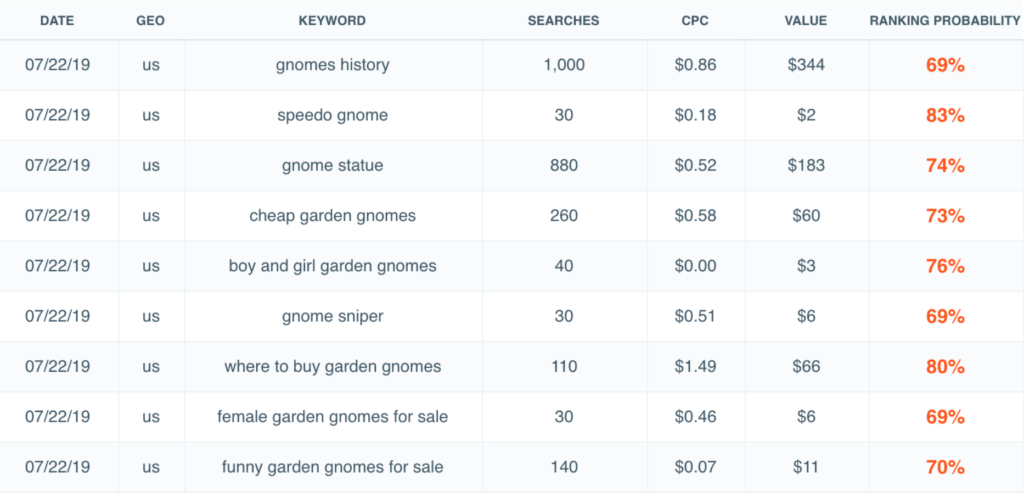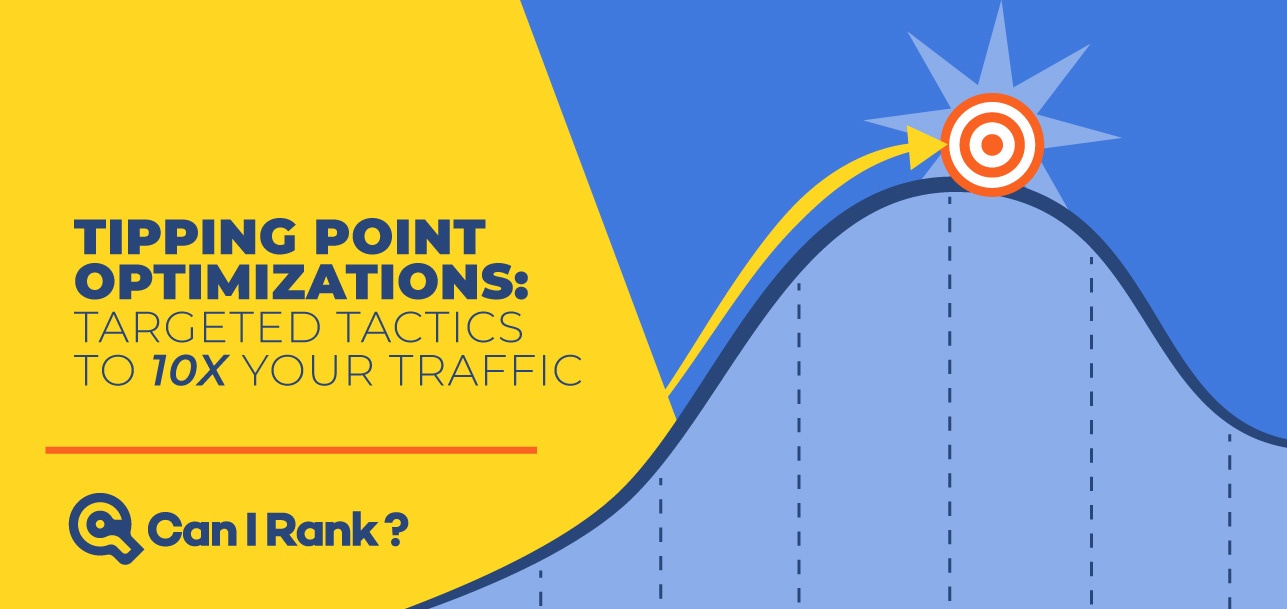You probably already know how valuable SEO can be for attracting new customers and staying ahead of the competition, but for one reason or another, it keeps getting pushed down on the to-do list.
Whether you’re already too busy juggling 100 other responsibilities or you’ve figured SEO is too difficult to manage, try out some of these strategies that take minimal effort but can help you maximize your results.
Smarter Keyword Targeting
I know, what you really want is to rank #1 for that big, juicy, popular term that defines your industry and attracts thousands upon thousands of clicks. There’s one problem: so does everyone else.
You have to be realistic with yourself. Did you just start your own garden gnome business? That’s great! But don’t expect to beat Amazon in the rankings for “garden gnome” as soon as you publish your first blog post or you’ll end up wasting a lot of valuable time. Instead, give yourself a fighting chance and start by targeting less competitive keywords.
There are lots of great tools for identifying these terms including CanIRank’s keyword research tool. The tool analyzes hundreds of data points covering your site’s authority, relevancy, optimization, and a number of other ranking factors to provide you with a full analysis and ranking probability score for any particular keyword. The higher the score, the more likely your site will rank for that keyword if you were to add targeted content.

Another popular resource is Google’s Keyword Planner which allows you to analyze traffic and trends for related keywords. Take a look at terms with low volume and low ad competition to get an idea of where to start.

Once you’re ranking well for the small stuff, your site will be that much stronger of a competitor. Once your site is stronger, you can target and feasibly rank for more competitive (i.e., valuable) terms. Repeat this process of keeping your level of challenge appropriate, and pretty soon you’ll be well on your way to garden gnome stardom.
Once you’ve started ranking for a wide net of keywords, you’ll need to figure out how to keep pushing those rankings upwards. However, just as before, you don’t want to spend all your time and effort on one keyword only for the actual traffic jump to look more like a tiny hop.
Avoid this by targeting “tipping point” opportunities. A page one ranking is way more valuable than a page two ranking, so start by looking for terms for which your site is ranking around 11-15. Just a little bit of content optimization or link building might be all you need to push the ranking over the edge for a nice boost in traffic. The same goes for terms for which your site is already ranking on the first page but not quite at the top: a move from ranking 2 to ranking 1 can completely change the game.
Clean Up Your Content
Maybe you’ve already got your site built out and established for a while now, but you’re just starting out with tackling SEO. You know you’ve gotta be smart with how you target keywords in your upcoming content, but what do you do with all the content you already have?
It’s time for an audit! Make a list of all the content on your site work your way down, making note of any of the following:
- Duplicate Content: Do you have multiple pages or sections of pages that are essentially identical? Major search engines aren’t a fan, and your users probably aren’t either. Make a note here to delete, merge, redirect, and/or update these pages. This can be a great opportunity for optimizing existing content for target keywords without having to write brand new articles. If you absolutely must keep the duplicate content, consider adding a canonical tag.
- Thin Content: Do you have pages with very little text (and thus very little helpful content for both users and search engines)? Consider employing similar strategies to those for duplicate content. If you can bulk up one of these pages with optimized content, it’s an easy win, or maybe you’ll find that combining two short articles results in a really comprehensive super article. If you really need to keep thin content pages, consider if it would be a good idea to add a noindex tag so search engines skip them altogether.
- Content Gaps: Are there certain topic areas for which you seem to be lacking coverage? Check out competitors’ sites and the keywords for which your target audience is searching. If you’re missing major themes, this could be an inspiration gold mine for the new content your users want to see and the relevant content search engines use to determine how they should rank your site.
- Top-Performing Content: Do you have one blog article that pulls in 10 times more traffic than any other? Does one feature page have a conversion rate that stands out above the rest? Take a deeper look and see if you can figure out why. The lessons you learn here can be applied to both new and existing content. Consider also if there are any factors hindering performance here. Is one blog post cannibalizing keywords from a highly converting landing page? Are there 3 different clicks a user needs to make to navigate to your top-performing page? Consider reorganizing or pruning content to ensure you always put your best foot forward.
Sometimes, looking at the content you already have can be just as if not more helpful as adding even more. By making purposeful decisions about your site’s content and organization, you’ll set yourself up for long-term success.
For an even deeper dive, check out our comprehensive guide to auditing content.
Technical SEO: It’s Easier Than It Sounds
Technical SEO is a scary topic for some, especially for those who tried it once, had no idea what they were doing, and gave up. Fortunately, it’s a lot simpler than you might think! In fact, many effective technical SEO improvements require very little technical knowledge at all.
Internal Linking
One valuable technical SEO strategy is the implementation of internal links. Internal links are just that: links that travel internally from one page on your site to another. You’ve probably already noticed a couple in this very article!
Internal linking is helpful because it helps search engines (and users) navigate your site and understand what it’s all about. Searchbots don’t often magically discover pages, so anything you can do to ease their crawling process is a plus. While navigating, they’re able to figure out the general topic area of any content on your site. By adding a link to or from that content, you indicate that the linking/linked page is at least in some way relevant to that content. Not only does this help search engines understand how your site is structured, it also gives them greater confidence in saying “this site’s content is clearly about garden gnomes, so it should be given extra weight in related rankings.”
Header Tags & Hierarchy
Your headers are also great indicators of what your site is about and how it’s organized. Header tags (<H1>, <H2>, etc.) help to highlight the major points of your site’s content, further establishing the topic at hand to users and search engines alike.
However, don’t just start header tagging everything. How you implement these tags is also important. A good rule of thumb is one <H1> tag per page (though every situation is unique). Beyond that, what’s important is making sure your header tags follow a clear hierarchy. The text in your <H2> tags should clearly serve the same function. For example:
Confusing header hierarchy:
- <H1> Garden Gnomes
- <H2> Sizes
- <H3> Large
- <H3> Small
- <H3> Colors
- <H4> Purple
- <H2> Blue
- <H3> Cerulean
- <H3> Lapiz
- <H2> Red
- <H3> Patterns
- <H4> Striped
- <H4> Polka Dots
- <H3> Patterns
- <H2> Green
- <H3> Striped
- <H2> Sizes
Understandable header hierarchy:
- <H1> Garden Gnomes
- <H2> Sizes
- <H3> Small
- <H3> Medium
- <H3> Large
- <H2> Colors
- <H3> Blue
- <H4> Cerulean
- <H4> Lapiz
- <H3> Red
- <H3> Green
- <H3> Purple
- <H3> Blue
- <H2> Patterns
- <H3> Striped
- <H3> Polka Dots
- <H2> Sizes
Titles & Meta Descriptions
Just like your headers, your page titles and meta descriptions help to add context so your content is easy to read and understand. Perhaps even more importantly, they can make or break your clickthrough rate. You can write some great content that ranks, but it’s not going to get you any traffic if nobody is clicking on your search result.
Be sure to include relevant copy that makes users actually want to click on your page. Consider the user’s intent in searching for that particular keyword phrase. If they’re searching for “garden gnome history,” they’re probably looking for more informational rather than transactional content and might be less inclined to click on a page from Buy Garden Gnomes Now, Inc. However, by clearly indicating your 4000-world article, “Oh Gnome You Didn’t: A History of Lawn Ornament Disputes,” covers an interesting aspect in garden gnomes history, you can improve your chances of earning a click and bringing a user that much closer to your site and your products.
SEO can be an intimidating topic for both new and experienced business owners, but it doesn’t have to be the scary monster some think it is. By working smart, not hard, and trying some of these quick and easy SEO strategies, you can make some significant improvements on your site with relatively little effort.




Leave A Comment